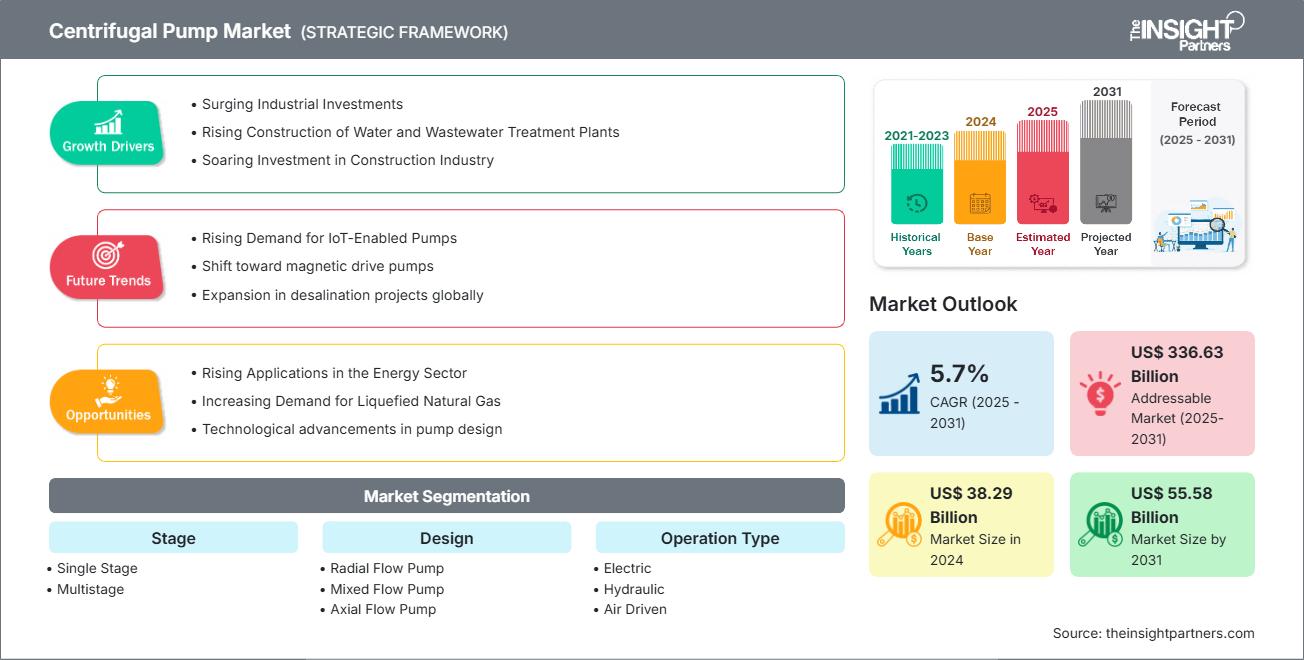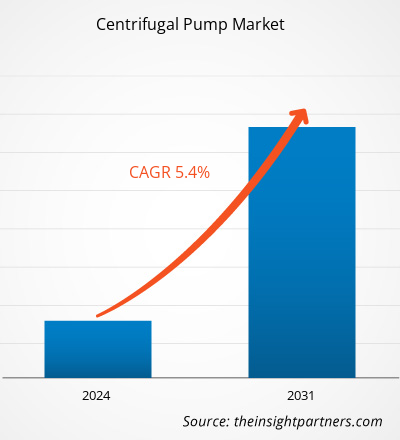离心泵市场规模预计将从 2024 年的 382.9 亿美元增至 2031 年的 555.8 亿美元。预计 2025-2031 年期间该市场的复合年增长率将达到5.7%。
离心泵市场分析
离心泵将旋转动能转化为流体动力能,用于流体输送。这类泵广泛应用于农业、供水和污水处理、化工、石油天然气以及建筑等领域。基础设施建设的增加和对水处理解决方案的需求是主要的增长动力。
离心泵市场概况
离心泵是各行各业流体处理基础设施的核心,是连接工业流程和市政供水系统的关键环节。主要设计类型包括单级泵和多级泵,并可根据叶轮类型(径向、轴向、悬臂式、两端轴承式)和流量类别进行进一步区分。
您可以免费定制任何报告,包括本报告的部分内容、国家级分析、Excel 数据包,以及为初创企业和大学提供优惠和折扣
离心泵市场:战略洞察

-
获取此报告的顶级关键市场趋势。此免费样品将包括数据分析,从市场趋势到估计和预测。
离心泵市场驱动因素和机遇
市场驱动因素:
-
基础设施和工业化增长:
城市化、建筑业和制造业的扩张推动了水、石油和天然气以及电力行业的需求。 -
水和废水需求:
对卫生设施和清洁水系统的投资,特别是在联合国可持续发展目标6等目标下的投资,推动了增长。 -
能源效率重点:
随着网络欺诈和网络攻击的增多,企业和客户需要安全的支付系统来保护他们的数据并阻止欺诈。 -
农业扩张:
对太阳能水泵和灌溉的补贴推动了亚洲和非洲农村地区的部署。 -
行业特定基础设施投资:
化工、制药、石油和天然气领域的需求不断增长。
市场机会:
-
智能泵系统的推出:
在工业 4.0、工业物联网的采用和不断增长的自动化需求的推动下,具有实时监控、预测性维护和数字孪生功能的智能泵可提高运营效率、减少停机时间并支持远程诊断。 -
采用可持续和绿色工程泵:
环保泵可降低能耗和排放,符合全球环境法规和可持续发展目标。各行各业均采用节能技术,以满足法规要求并提升环境、社会和治理 (ESG) 绩效。 -
对可定制和模块化泵的需求:
制药和化工行业青睐模块化泵设计,以实现可扩展性、材料兼容性和工艺灵活性。定制化设计可确保在复杂或受监管的应用中实现高效集成、快速部署和定制性能。 -
向新兴地区扩张:
由于城市化进程加快以及在原有系统不足的情况下对现代水、废水和工业基础设施的需求,亚太地区、拉丁美洲和中东和非洲地区的新兴市场带来了增长机会。
离心泵市场报告细分分析
离心泵市场细分为不同的细分市场,以便更清晰地了解其运作方式、增长潜力和最新趋势。以下是大多数行业报告中使用的标准细分方法:
按阶段:
-
单级:
单级泵在全球离心泵市场占据主导地位,预计到2024年将占据大部分市场份额。这类泵因其设计简单、初始成本低、维护方便而备受青睐。它们适用于需要中等流量和压力的应用,例如农业、供水和轻工业任务。 -
多级:
多级泵虽然更复杂,但在锅炉给水、深井泵送以及油气作业等高压应用中至关重要。它们的使用正在稳步增长,尤其是在发电、采矿和基础设施项目中。
按设计:
-
径流泵:
这是最常见的离心泵类型,其流体垂直于泵轴排出。它们广泛用于工业、市政和商业应用,尤其适用于高压、低流量工况。
-
混流泵:
这些泵兼具径向和轴向流动特性,提供适中的扬程和流量。它们是灌溉、防洪和冷却水系统的理想选择。
-
轴流泵:
这些泵设计用于低扬程输送大量水,适用于排水、循环和船舶应用。随着人们对废水和洪水管理的日益关注,轴流泵的需求也在增长,尤其是在亚太地区。
按操作类型:
- 电的
- 液压
- 气动
按类型:
- 悬臂叶轮
- 垂直悬挂
- 轴承间
按最终用户:
- 工业的
- 住宅
- 农业
- 商业的
按地域划分:
- 北美
- 欧洲
- 亚太地区
- 拉美
- 中东和非洲
离心泵市场区域洞察
Insight Partners 的分析师已详尽阐述了预测期内影响离心泵市场的区域趋势和因素。本节还讨论了北美、欧洲、亚太地区、中东和非洲以及南美和中美洲的离心泵市场细分和地域分布。
离心泵市场报告范围
| 报告属性 | 细节 |
|---|---|
| 2024年的市场规模 | 382.9亿美元 |
| 2031年的市场规模 | 555.8亿美元 |
| 全球复合年增长率(2025-2031) | 5.7% |
| 史料 | 2021-2023 |
| 预测期 | 2025-2031 |
| 涵盖的领域 |
按阶段
|
| 覆盖地区和国家 |
北美
|
| 市场领导者和主要公司简介 |
|
离心泵市场参与者密度:了解其对业务动态的影响
离心泵市场正在快速增长,这得益于终端用户需求的不断增长,而这些需求的驱动因素包括消费者偏好的转变、技术进步以及对产品优势的认知度的提升。随着需求的增长,企业正在扩展产品线,不断创新以满足消费者需求,并抓住新兴趋势,从而进一步推动市场增长。

- 获取离心泵市场主要参与者概览
离心泵市场份额按地区分析
在快速工业化、农业扩张和基础设施项目的推动下,亚太地区正经历显著增长。拉丁美洲、中东和非洲等新兴市场为离心泵供应商提供了许多尚未开发的扩张机会。
由于市场成熟,石油天然气、水务设施以及监管驱动的升级改造领域存在稳定的机会,各地区离心泵市场的增长情况各有不同。以下是各地区市场份额和趋势的总结:
1. 北美
-
市场份额:
占据全球离心泵市场的很大份额 -
关键驱动因素:
- 强大的基础设施和工业基础,包括石油和天然气、化学品和水处理
- 页岩气和发电等能源领域的需求巨大
- 陈旧的市政供水和污水处理系统正在推动更换和升级的需求
-
趋势:
公用事业和工业领域对可再生能源和改造项目的投资不断增加
2.欧洲
-
市场份额:
占比巨大,尤其是在工业和环境应用领域 -
关键驱动因素:
- 严格的欧盟环境法规(例如生态设计指令)促进节能泵的发展
- 成熟的制造业、化工业和制药业
- 水循环和废水处理需求旺盛
-
趋势:
越来越多地采用支持物联网的泵和状态监测解决方案
3. 亚太地区
-
市场份额:
增长最快的地区,市场份额逐年上升 -
关键驱动因素:
- 快速城镇化、工业化和农业机械化
- 政府对灌溉、废水处理和智慧城市项目的投资
- 中国、印度和东南亚的发电能力和石油天然气勘探活动不断增长
-
趋势:
高度重视本地化制造和具有成本效益的产品线
4.南美洲和中美洲
-
市场份额:
中等规模且不断扩张,农业和采矿业的需求不断增加 -
关键驱动因素:
- 巴西和阿根廷农业灌溉需求不断增长
- 智利和秘鲁采矿和矿产加工行业不断扩大
- 努力改善供水和卫生基础设施
-
趋势:
发展援助和外国投资正在推动水利和公用事业基础设施项目
5.中东和非洲
-
市场份额:
尽管规模较小,但增长迅速 -
关键驱动因素:
- 大力投资海湾合作委员会国家的海水淡化厂、区域制冷以及石油和天然气设施
- 农业和农村发展迫切需要可靠的抽水解决方案
- 撒哈拉以南非洲的发电和采矿业增长
-
趋势:
旨在改善供水和防洪系统的基础设施升级
离心泵市场参与者密度:了解其对业务动态的影响
市场密度高,竞争激烈
主要的全球参与者包括 Xylem Inc.、Grundfos、Flowserve、KSB SE & Co.、Sulzer、Ebara、Weir Group、Wilo 和 ITT Corp.,以及 Kirloskar Brothers(印度)等地区领导者。
- 战略差异化强调节能设计、物联网智能监控、模块化配置以及预测性维护等增值服务。
机遇与战略举措
- 全球扩张(例如,Xylem 在埃及开设新工厂)、并购以及智能和可持续泵的产品创新。
离心泵市场的主要公司有:
- 荏原公司
- 格兰富控股公司
- 基洛斯卡兄弟有限公司
- 苏尔寿有限公司
- 威尔集团
- 赛莱默公司
- Gorman-Rupp泵
- 法孚特种部队
- 阿特拉斯·科普柯公司
- 派克汉尼汾公司
免责声明:以上列出的公司没有按照任何特定顺序排列。
研究过程中分析的其他公司:
- KSB SE & Co KGaA
- 普洛格工业公司
- 鹤见制作所
- 威乐
- SHI低温集团
离心泵市场新闻及最新发展
-
苏尔寿与 Manweir 在卡塔尔签署 10 年战略服务合作伙伴关系
苏尔寿与领先的工程服务提供商 Manweir WLL(Mannai 集团的石油和天然气部门)合作,以提高卡塔尔旋转设备维修和服务的可用性和质量。 -
苏尔寿在墨西哥开设新的高性能泵工厂
苏尔寿最近庆祝了其在墨西哥城的新测试和装配中心的正式启用,该中心与现有的泵制造工厂一起建造。 -
赛莱默完成对 Evoqua 的收购
全球领先的水技术公司赛莱默公司(“赛莱默”或“公司”)宣布已完成对关键任务水处理解决方案和服务领域的领导者 Evoqua Water Technologies Corp.(“Evoqua”)的收购,此次全股票交易价值约为 75 亿美元。
离心泵市场报告覆盖范围和交付成果
《离心泵市场规模和预测(2021-2031)》报告对以下领域进行了详细的市场分析:
- 离心泵市场规模以及涵盖范围内所有主要细分市场的全球、区域和国家层面的预测
- 离心泵市场趋势以及市场动态,如驱动因素、限制因素和关键机遇
- 详细的 PEST 和 SWOT 分析
- 离心泵市场分析涵盖主要市场趋势、全球和区域框架、主要参与者、法规和最新市场发展
- 行业格局和竞争分析,涵盖市场集中度、热图分析、知名参与者以及离心泵市场的最新发展
- 详细的公司简介
- 历史分析(2 年)、基准年、预测(7 年)及复合年增长率
- PEST和SWOT分析
- 市场规模、价值/数量 - 全球、区域、国家
- 行业和竞争格局
- Excel 数据集
近期报告
相关报告
客户评价
购买理由
- 明智的决策
- 了解市场动态
- 竞争分析
- 客户洞察
- 市场预测
- 风险规避
- 战略规划
- 投资论证
- 识别新兴市场
- 优化营销策略
- 提升运营效率
- 顺应监管趋势






















 获取免费样品 - 离心泵市场
获取免费样品 - 离心泵市场